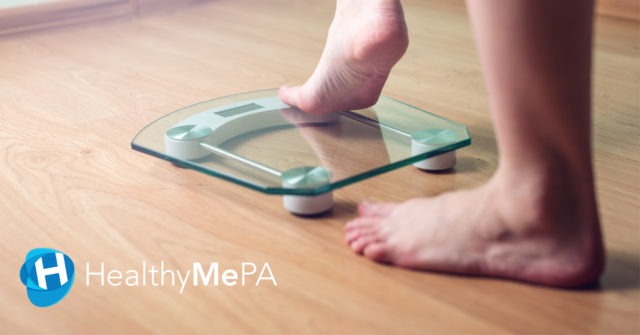Technically, there are no specific obesity “symptoms.” When you consume more calories than you burn—and they are stored as fat—over an extended time, you gain enough weight to become obese. The most common signs are a high body mass index (BMI) and unhealthy body fat distribution.

What are the signs of obesity?
Calculate your own BMI
BMI is a measure of body fat based on your weight in relation to your height, and it applies to most adults 20 and older. You and your doctor can use it as a screening tool to identify potential weight problems.
Take your weight in pounds, multiply it by 703 and divide that answer by your height in inches, squared.
Example: You weigh 150 pounds and are 5 feet, 8 inches tall, or 68 inches.
150 x 703 = 105,450/68×68 = 105,450/4,624 = 22.8 BMI
BMI Result Chart
Classification BMI
Underweight below 18.5
Healthy weight 18.5 to 24.9
Overweight 25 to 29.9
Obese 30 or above
Waist circumference
Another sign of obesity is an increased waist circumference, which suggests there is extra fat in the abdomen. That increases your risk of obesity-related complications. According to or women, a waist circumference greater than 35 inches, and for men greater than 40 inches, puts you at risk of heart disease, stroke, or Type 2 diabetes. To measure your waist, stand and place a tape measure around your middle, just above your hip bones. Measure your waist just after you breathe out.
Why me and not you?
We all know people who can eat whatever they want and stay thin. Today, though, nearly 38 percent of American adults are obese, according to the 2016 State of Obesity report. Research is showing that behavior, environment, and genetics all impact the development of obesity.
Behavior: The type and amount of food you eat and the physical activity you do impact your weight.
Environment: Your environment can shape your habits and lifestyle. We sit a lot more than our ancestors, drive instead of walk, and reach for convenience foods instead of balanced meals.
Genetics: Research is showing that, in rare cases, genes can cause disorders that result in obesity. However, most obesity results from interactions between genes and environmental factors—although research is ongoing.
How do you know?
If you’re concerned about your weight, BMI, or waist measurements, see your doctor. You’ll discuss your eating and physical activity habits, family history, and any difficulties you have. This and perhaps other screening methods such as blood tests and ultrasounds can help determine if another condition is causing you to be overweight or if you have health complications from being obese.
This is serious
More than 112,000 annual deaths can be tied to obesity, and more than 40 medical conditions are associated with it. The most common are:
- Type 2 diabetes
- High cholesterol
- High blood pressure, heart attack and stroke
- Sleep apnea
- Reflux
- Osteoarthritis
- Some cancers
Fighting obesity
It takes time, patience and regular doctor visits to keep track of your health and aim for a healthy weight. Your doctor might suggest behavior modification, physical activity, non-clinical weight management programs, medical weight management, medications, or bariatric surgery.
To get started, here are weight-loss tips:
- Use a food and activity tracker. Many free and paid apps can keep fitness and calorie goals on track
- Set specific, realistic fitness goals. Your doctor can help
- Don’t change everything at once. Small steps that you can achieve make for lasting weight loss
- Learn from setbacks. Everyone slips. Figure out what tripped you up and get back on track
- Celebrate wins. Find non-food rewards for yourself—a movie, workout clothes, a visit with a friend
- Identify and avoid temptations. Does watching TV make you snack? Form plans to avoid your traps
- Buddy up for exercise. You’re more likely to stick with it if you have a friend counting on you, too
If your BMI and waist size are creeping up the charts, don’t wait to check in with your doctor. Get a picture of your overall health and make a plan to keep yourself out of the danger zone.
